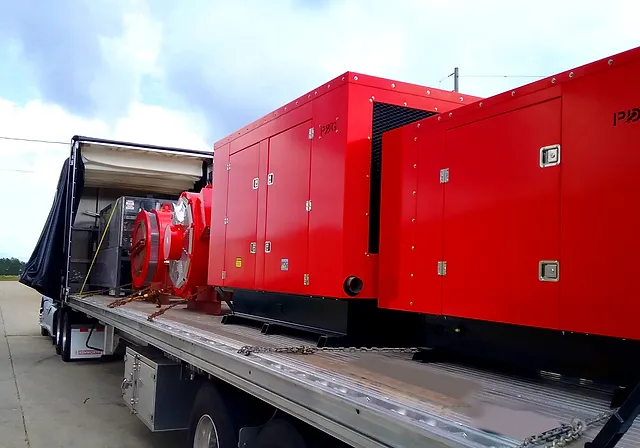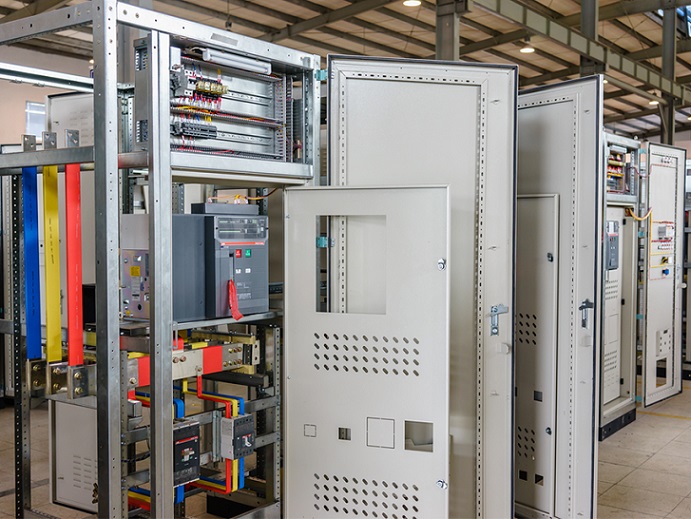Diesel generators are a great option for businesses that need reliable and uninterrupted power supply during emergencies or power outages. Diesel generators have many advantages over other types of generators, such as:
- Fuel efficiency: Diesel generators consume less fuel than gasoline or propane generators, which means lower operational costs and less environmental impact.
- Durability: Diesel generators are designed to withstand harsh conditions and heavy loads, which means longer lifespan and less maintenance.
- Reliability: Diesel generators are less prone to failures and malfunctions than other generators, which means more consistent and dependable performance.
However, choosing the right size of diesel generator is not as simple as it may seem. If you choose a generator that is too large or too small for your power needs, you may face some serious problems, such as:
- Damage to electrical systems: A generator that is too large may produce more voltage than your electrical systems can handle, which may cause overheating, short circuits, or fires. A generator that is too small may not be able to provide enough power for your electrical systems, which may cause fluctuations, brownouts, or blackouts.
- Unnecessary operational expenses: A generator that is too large may waste fuel and energy, which may increase your operational costs and carbon footprint. A generator that is too small may require frequent refueling and maintenance, which may also increase your operational costs and downtime.
- Insufficient or unreliable power: A generator that is too large or too small may not be able to meet your power demands during an outage, which may affect your business operations, productivity, and customer satisfaction. Moreover, a generator that is too large or too small may not be able to power your critical facilities and security systems, which may compromise your safety and security.

Therefore, it is essential to choose a generator that is just right for your power needs. But how do you do that? Here are some steps to follow:
Step 1: Calculate your power needs
The first step is to calculate how much power you need to run your appliances and equipment during an outage. To do that, you need to make a list of all the appliances and equipment that you need to power, and add up their wattage. Wattage is the amount of power that an appliance or equipment consumes per unit of time, and it is usually measured in watts (W) or kilowatts (kW).
However, there is a catch. Not all appliances and equipment consume the same amount of power all the time. Some appliances and equipment have two different wattage ratings: starting watts and running watts. Starting watts are the amount of power that an appliance or equipment needs to start up, and they are usually higher than running watts. Running watts are the amount of power that an appliance or equipment needs to operate normally, and they are usually lower than starting watts.
For example, a refrigerator may have a starting wattage of 1200 W and a running wattage of 200 W. This means that the refrigerator needs 1200 W of power to start up, but only 200 W of power to run continuously. Similarly, an air conditioner may have a starting wattage of 3000 W and a running wattage of 1500 W. This means that the air conditioner needs 3000 W of power to start up, but only 1500 W of power to run continuously.
Therefore, when calculating your power needs, you need to consider both the starting and running watts of your appliances and equipment. To do that, you need to find out the wattage ratings of your appliances and equipment, either from their labels, manuals, or online sources. Then, you need to add up the starting watts of all the appliances and equipment that you need to start at the same time, and the running watts of all the appliances and equipment that you need to run continuously. The sum of the starting watts is your peak power demand, and the sum of the running watts is your average power demand.
For example, suppose you need to power the following appliances and equipment during an outage:
| Appliance/Equipment | Starting Watts | Running Watts |
| Refrigerator | 1200 W | 200 W |
| Air Conditioner | 3000 W | 1500 W |
| TV | 200 W | 200 W |
| Laptop | 100 W | 100 W |
| Lights | 300 W | 300 W |
| Total | 4800 W | 2300 W |
In this case, your peak power demand is 4800 W, and your average power demand is 2300 W.
Step 2: Choose a generator that can handle your power needs
The second step is to choose a generator that can handle both your peak and average power needs. To do that, you need to compare the wattage ratings of the generators with your power needs. The wattage ratings of the generators are usually expressed in terms of rated power and maximum power. Rated power is the amount of power that a generator can produce continuously, and it is usually lower than maximum power. Maximum power is the amount of power that a generator can produce for a short period of time, and it is usually higher than rated power.
For example, a generator may have a rated power of 5000 W and a maximum power of 5500 W. This means that the generator can produce 5000 W of power continuously, but can produce up to 5500 W of power for a short period of time.
Therefore, when choosing a generator, you need to make sure that its rated power is equal to or greater than your average power demand, and its maximum power is equal to or greater than your peak power demand. This will ensure that the generator can provide enough power for your appliances and equipment without overloading or underloading.
For example, suppose your peak power demand is 4800 W, and your average power demand is 2300 W. In this case, you need to choose a generator that has a rated power of at least 2300 W, and a maximum power of at least 4800 W. A generator that has a rated power of 5000 W and a maximum power of 5500 W would be a good choice, as it can handle both your peak and average power needs.
Step 3: Choose a generator that has a larger fuel tank for longer run time
The third step is to choose a generator that has a larger fuel tank for longer run time. The run time of a generator is the amount of time that a generator can run on a full tank of fuel, and it is usually measured in hours. The run time of a generator depends on the size of the fuel tank, the fuel consumption rate, and the load on the generator.
The size of the fuel tank is the amount of fuel that a generator can hold, and it is usually measured in liters (L) or gallons (gal). The fuel consumption rate is the amount of fuel that a generator consumes per unit of time, and it is usually measured in liters per hour (L/h) or gallons per hour (gal/h). The load on the generator is the percentage of the rated power that the generator is producing, and it is usually expressed in terms of 25%, 50%, 75%, or 100%.
For example, a generator may have a fuel tank size of 15 L, a fuel consumption rate of 2 L/h, and a rated power of 5000 W. This means that the generator can hold 15 L of fuel, and it consumes 2 L of fuel per hour. If the generator is running at 50% load, which means it is producing 2500 W of power, then the run time of the generator is 7.5 hours.
Therefore, when choosing a generator, you need to consider how long you need the generator to run during an outage, and how much fuel you can store or access. You need to choose a generator that has a larger fuel tank for longer run time, and a lower fuel consumption rate for lower operational costs and environmental impact.
For example, suppose you need the generator to run for at least 10 hours during an outage, and you can store or access up to 20 L of fuel. In this case, you need to choose a generator that has a fuel tank size of at least 20 L, and a fuel consumption rate of less than 2 L/h. A generator that has a fuel tank size of 25 L and a fuel consumption rate of 1.5 L/h would be a good choice, as it can run for up to 16.7 hours on a full tank of fuel.

Step 4: Choose a generator that has a built-in automatic transfer switch
The fourth and final step is to choose a generator that has a built-in automatic transfer switch. An automatic transfer switch is a device that automatically transfers power from the utility to the generator when the power goes out, and vice versa when the power comes back on. This ensures a seamless transition between the two power sources, and prevents any damage or disruption to your electrical systems, appliances, and equipment.
An automatic transfer switch can be either built-in or external. A built-in automatic transfer switch is integrated into the generator itself, and it is usually easier to install and operate. An external automatic transfer switch is a separate device that is connected to the generator and the utility, and it is usually more expensive and complex to install and operate.
Therefore, when choosing a generator, you need to consider the convenience and safety of having a generator that has a built-in automatic transfer switch, and choose one that has this feature. This will save you time and hassle of manually switching the power sources, and protect your electrical systems, appliances, and equipment from damage or disruption.
Conclusion
Choosing the right size of diesel generator for your business is not a trivial task, but it is a worthwhile investment that can ensure your business continuity, productivity, and security during emergencies or power outages.
By following the steps outlined in this blog, you can calculate your power needs, compare the wattage ratings of the generators, choose a generator that has a larger fuel tank for longer run time, and choose a generator that has a built-in automatic transfer switch.

Some of the reputable brands of diesel generators that are known for their quality and reliability are:
- Cummins: Cummins is a global leader in power generation solutions, offering a wide range of diesel generators for various applications and industries. Cummins diesel generators are designed to deliver high performance, low maintenance, and low emissions, and they come with advanced features such as remote monitoring, load management, and noise reduction.
- Caterpillar: Caterpillar is a world-renowned manufacturer of heavy equipment and power systems, offering a comprehensive portfolio of diesel generators for diverse needs and environments. Caterpillar diesel generators are engineered to provide reliable, durable, and efficient power, and they come with integrated solutions such as automatic transfer switches, switchgear, and control panels.
- Generac: Generac is a leading provider of backup power solutions, offering a variety of diesel generators for residential, commercial, and industrial use. Generac diesel generators are built to withstand harsh conditions and heavy loads, and they come with smart features such as digital controllers, fuel level indicators, and battery chargers.
We hope this blog has helped you understand how to choose the right size of diesel generator for your business. If you have any questions or comments, please feel free to contact us. We are always happy to help. Thank you for reading. 😊